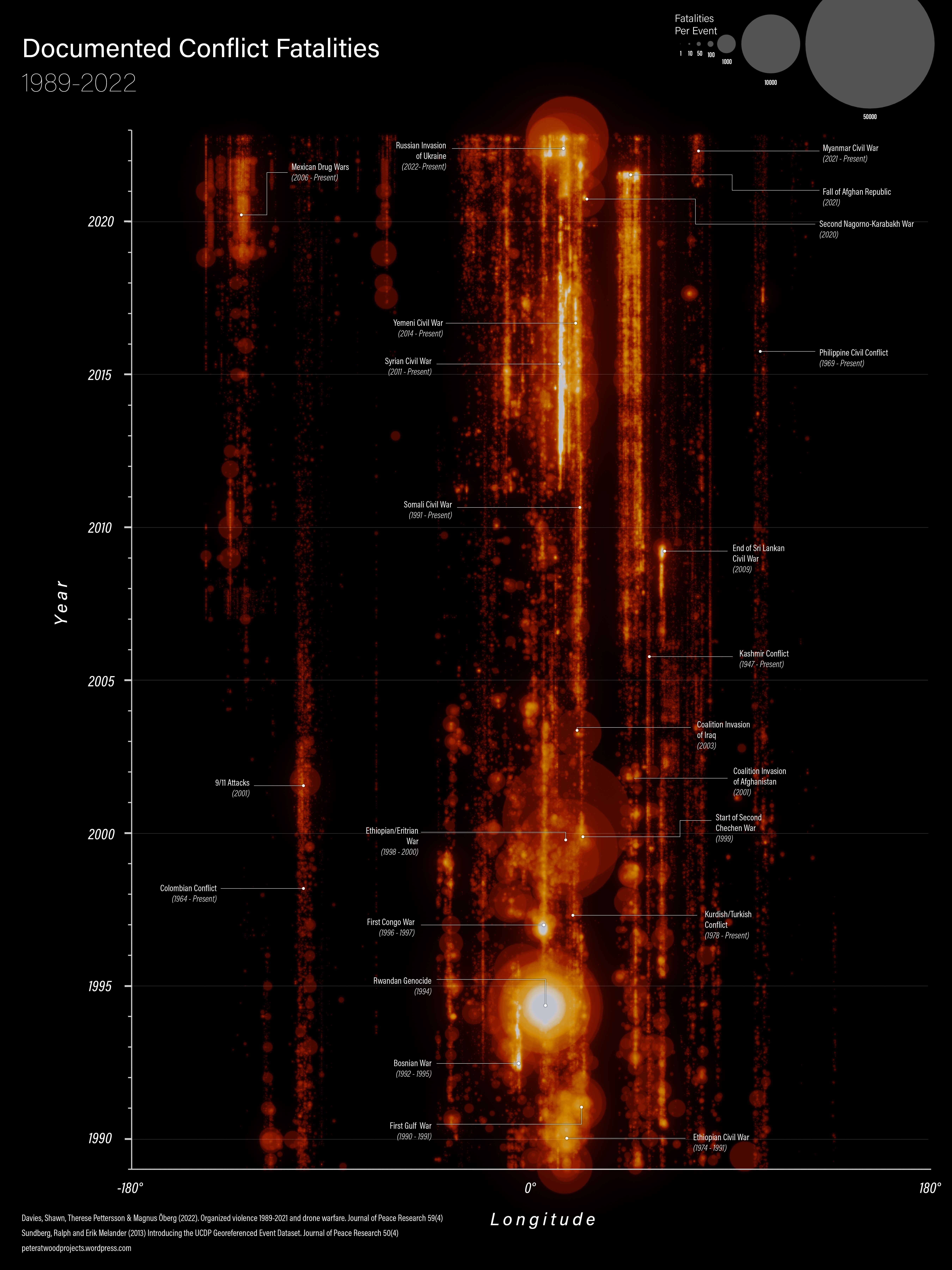Submitted by TheBroadHorizon t3_10attlh in dataisbeautiful
Comments
TheBroadHorizon OP t1_j464n3o wrote
Data Source: Uppsala Conflict Data Program
Tools Used: Blender, Python, Illustrator, Photoshop
This visualization shows documented conflict fatalities since 1989 as recorded by the Uppsala Conflict Data Program. Each point represents a single event in the dataset with at least one fatality plotted by date and longitude. The size of the points corresponds to the number of fatalities. The brightness corresponds to the density of points (ie. the number of events occurring in roughly the same time/place) A couple of notes about this visualization:
- Exactly what counts as a "conflict death" is inevitably quite fuzzy. Do you count conflicts between police and criminal organizations? Political assassinations? The definitions that the UCDP uses can be found here: definitions, methodology
- Since this visualization only accounts deaths that could be verifiably documented, it likely undercounts the true death toll in many cases, particularly in areas where outside observers have limited access. Each event is assigned a range of casualties based on the different sources that were found. This visualization used the best estimate for each event.
- What constitutes an "event" varies throughout the dataset depending on how different conflicts were documented. In some conflicts fatalities were aggregated after the fact and appear as a handful of large points. In other conflicts the data is much more granular and is composed of a large number of smaller points.
I've also put together a variant that colours the points by continent (link), and one that plots each continent individually (link).
I've also put together a variant that colours the points by continent (link), and one that plots each continent individually (link).
JPAnalyst t1_j47ge9x wrote
Incredible to look at. Great work on this. Creative and beautiful. Sad data though.
GrizzlyHerder t1_j48stqk wrote
Agree.
I had heard, often about the Rwandan Genocide, but it’s global presence/‘footprint’ here is HUGE.
So much pain & suffering ! But thanks for the enlightening perspective.
JPAnalyst t1_j496usv wrote
Yeah. Rwanda isn’t just a movie “Hotel Rwanda” and I don’t pretend to know a lot about the genocide, but this is sobering data. So many innocent lives. Mom’s, dads, sons, daughters, families, children. In the West, we just overlook this stuff as some blip in the news that doesn’t concern us. “It’s just some poor nation that can’t get their shit together. Whateves” is often the mentality. It’s terrible.
swankpoppy t1_j49law8 wrote
Wow this is a really fantastic visualization. Thanks OP
kultsinuppeli t1_j47mzxo wrote
This is really cool! I stared at it for a long time just looking at how nicely and interestingly it's depicted! Good job!
lazyzefiris t1_j49wcn3 wrote
This looks a lot like an actual non-random-noise spectrogram (save for large circles), wonder how it would sound...
[deleted] t1_j48gog8 wrote
[removed]
[deleted] t1_j498qdm wrote
[removed]
andrewloomis t1_j49lht4 wrote
What is considered here as “fatalities” only civil deaths or military too? Because if second, there are already 100 000 dead ruzkies and that don’t correspond to circles above right. Same with Rwanda.
TheBroadHorizon OP t1_j49uso1 wrote
The dataset includes both civilian and military casualties. Conflicts that are currently active are typically undercounted since fatalities are only added to the database when they can be documented by a third party (i.e. not one of the participants in the conflict). In the case of Russia and Ukraine, most of the casualty reports are coming from the Russian and Ukrainian governments. The database currently lists approximately 65,000 confirmed fatalities up to November 2022 which are shown in the chart.
For the Rwandan genocide, the chart shows approximately 550,000 fatalities which is in line with the general scholarly consensus. Note that the bright spot indicates a large number of overlapping events that occurred at roughly the same time.
mynameismy111 t1_j4ahzt3 wrote
This is cool and should be applied to more times and events
Familiar-Kangaroo375 t1_j4r5k32 wrote
Excuse me, the Myanmar civil war has been occurring since 1962 at least
TheBroadHorizon OP t1_j4rclkr wrote
While there has been civil conflict in the country for decades, the current civil war is generally recognized to have begun in the aftermath of the February 2021 military coup.

fun-slinger t1_j466bgd wrote
This is really cool. Have you considered normalizing by available landmass per meridian? Additionally I'd love to see this done along the lines of latitude for a longer period of record. I would suspect that as climatic conditions shift to extremes/higher variability you'd see an interesting pattern with fatalities being higher in the equator lats than poleward ones.
Nic work!